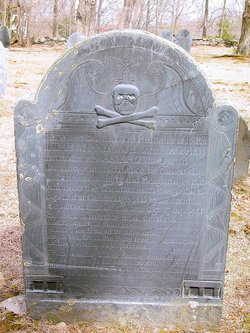Studying America’s Earliest Jewish Communities
The Wyner Family Jewish Heritage Center at the New England Historic Genealogical Society is offering an online course on “Freedoms and Challenges: America’s Earliest Jewish Communities, 1650–1840” starting on 2 March.
The course description says:
There are four classes scheduled, all at 4:00 to 5:30 P.M. on Tuesdays:
The photo above shows the gravestone of Judah Monis. Its first part reads:
Monis was the most prominent man of Jewish ancestry in eighteenth-century Massachusetts, especially since there was practically no competition. Unlike Newport, Rhode Island, colonial Boston didn’t have enough Jewish people to form a community.
Monis was born in Italy in a family that had converted to Christianity under pressure, but he studied at Jewish academies there and in the Netherlands. He arrived in New York in 1715. Five years later, Monis came to Harvard College, earning an M.A. degree by writing a Hebrew grammar. The college asked him to teach Hebrew but required that he adopt Congregationalism. Monis’s conversion was controversial for both Jews and Christians in America, and he never became a professor, only an instructor connected to the college. Nonetheless, he was respected as the expert on his topic for decades. In his final years Monis lived with relatives in Northboro, where he was buried.
The course description says:
American Jewish history begins over 100 years before the United States was founded, and the experiences of the earliest Jews lay out the foundational themes of America itself. In this four-part course we will explore the writings, architecture, ideas, and daily lives of American’s earliest Jewish individuals and communities—lives that were vigorous, variegated, and experimental.The teacher is Ellen Smith, Professor Emerita at Brandeis University. In September 2020 she retired as Director of the Hornstein Jewish Professional Leadership Program, having taught in the Department of Near Eastern and Judaic Studies and the Heller School for Social Management. Trained as a professional historian and a museum curator, Smith has produced over three dozen books, articles, and exhibitions on American Jewish history. She is the co-author and editor, with Jonathan D. Sarna, of The Jews of Boston and was the chief consultant to the Emmy award-winning WGBH television show of the same name. Prof. Smith is a past Curator of the American Jewish Historical Society, and was the Chief Curator in the planning stage of the National Museum of American Jewish History in Philadelphia.
Issues they faced still concern us today: desires of individuals vs. communities; the relationships of different communities to one another; how experiences differ by generation, geography, and gender; and the overall strategies, choices, and responses we make in creating and securing our identities in a nation that does not fully define them for us.
There are four classes scheduled, all at 4:00 to 5:30 P.M. on Tuesdays:
- 2 March: Accidents and Opportunities
- 9 March: Promise or Peril?
- 16 March: American and Jewish Revolutions
- 23 March: Beyond the Northeast
The photo above shows the gravestone of Judah Monis. Its first part reads:
Here lies buried the remains of RABBIAfter that are quotations from five Bible verses, three from the Hebrew Bible and two from the New Testament.
JUDAH MONIS, MA, late HEBREW
instructer at HARVARD College in
Cambridge in which office he continued 40
years. He was by Birth and Religion a Jew but
embrac’d the Christian faith & was publickly
baptiz’d at Cambridge, AD 1722 and
departed this life April 25, 1764 Aged
81 years 2 months and 21 days.
Monis was the most prominent man of Jewish ancestry in eighteenth-century Massachusetts, especially since there was practically no competition. Unlike Newport, Rhode Island, colonial Boston didn’t have enough Jewish people to form a community.
Monis was born in Italy in a family that had converted to Christianity under pressure, but he studied at Jewish academies there and in the Netherlands. He arrived in New York in 1715. Five years later, Monis came to Harvard College, earning an M.A. degree by writing a Hebrew grammar. The college asked him to teach Hebrew but required that he adopt Congregationalism. Monis’s conversion was controversial for both Jews and Christians in America, and he never became a professor, only an instructor connected to the college. Nonetheless, he was respected as the expert on his topic for decades. In his final years Monis lived with relatives in Northboro, where he was buried.


